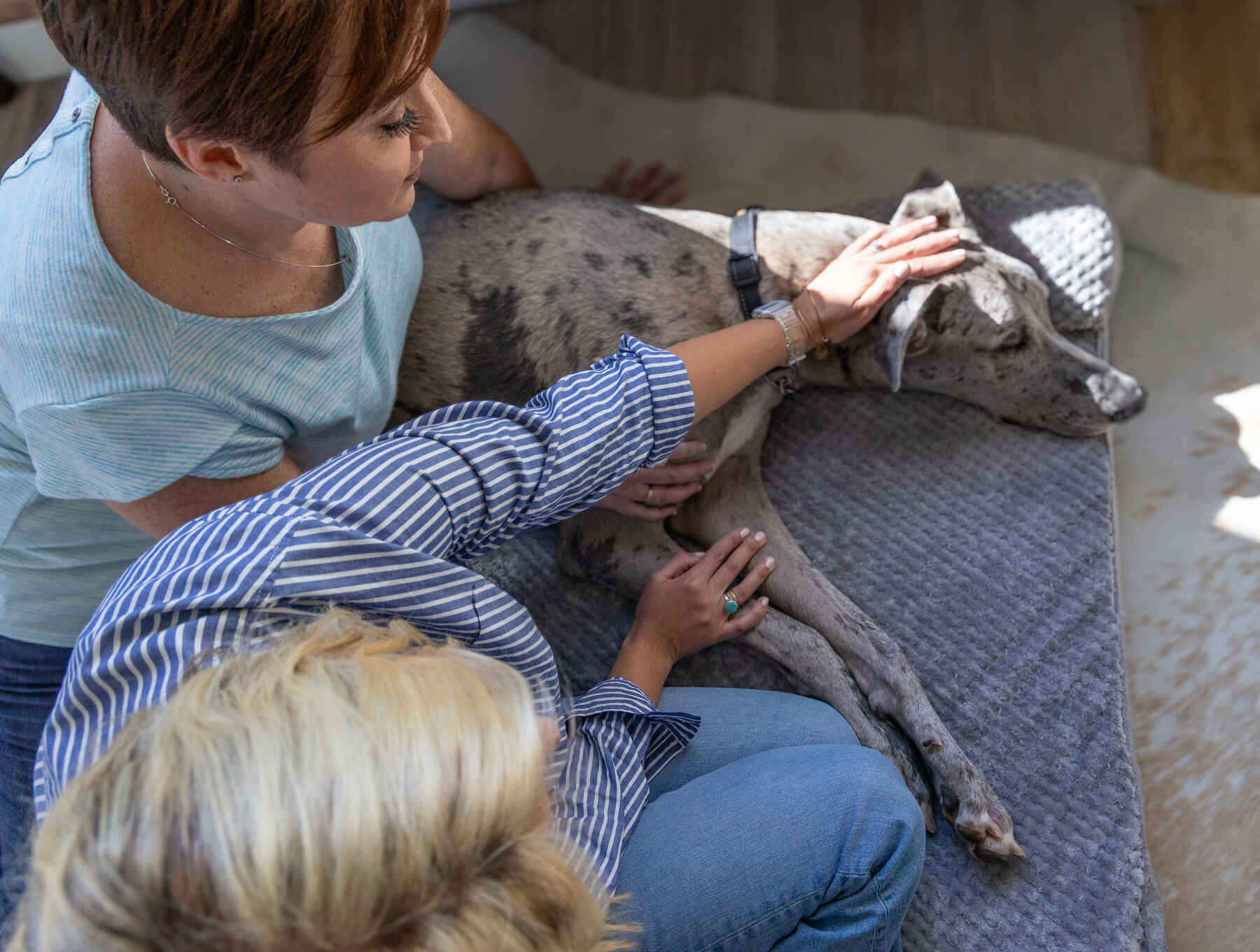What do I do if my dog passed away at home at night? The immediate steps involve confirming your dog has passed, providing respectful body care, deciding on aftercare (burial or cremation), and seeking emotional support. This guide will walk you through each step to help you navigate this difficult time.
Losing a beloved dog is heartbreaking, and the experience can be even more overwhelming when it happens unexpectedly at home during the night. The shock and grief can make it difficult to think clearly, but knowing what to do beforehand can provide a sense of control and ensure your dog is treated with dignity and respect. This step-by-step guide offers practical advice and emotional support to help you through this challenging experience.

Image Source: pawsintograce.com
Confirming Your Dog Has Passed Away
The first step is to confirm that your dog has actually passed away. This can be emotionally difficult, but it’s important to be certain.
- Check for Breathing: Look closely at your dog’s chest for any rise and fall. Place your hand gently near their nose to feel for any breath.
- Check for a Heartbeat: Place your hand on the left side of your dog’s chest, just behind their front leg. Listen carefully for a heartbeat. If you have a stethoscope, you can use it to listen more clearly.
- Check for Responsiveness: Gently try to rouse your dog. Call their name softly or gently touch them. Observe for any response, such as a twitch or eye movement.
- Check the Gums: The gums will become pale or even bluish in color.
- Check the Eyes: The eyes may be open and unfocused, and the pupils will be dilated and unresponsive to light.
If you are still unsure, it’s best to contact an emergency vet. They can confirm the passing and offer guidance.
Immediate Steps After Dog Dies
Once you have confirmed that your dog has passed away, it’s time to take a few immediate steps. These steps will help preserve your dog’s body and give you time to make decisions about aftercare.
- Move Your Dog to a Cool Place: If possible, move your dog’s body to a cooler area of your home, such as a garage or basement. This will help slow down decomposition.
- Place a Towel Underneath: Place a thick towel or blanket underneath your dog to absorb any fluids that may be released.
- Gently Close the Eyes: If your dog’s eyes are open, gently close them.
- Position the Body: Lay your dog in a natural, comfortable position.
- Contact Your Vet (or Emergency Vet): Even if your dog has passed, it is important to inform your veterinarian. If it is nighttime, contact an emergency veterinary clinic for guidance, especially if you are unsure of the cause of death. They can provide documentation for cremation or burial, and they can offer support and resources for pet loss grief support.
Respectful Dog Body Care
Showing respect for your dog’s body is a crucial part of the grieving process. Here are some guidelines for respectful dog body care:
- Handle with Care: Treat your dog’s body with the same care and respect you showed them in life.
- Clean the Body: Gently clean any discharge from the nose, mouth, or rear end with a soft, damp cloth.
- Wrap the Body: Wrap your dog in a clean blanket or sheet. This will provide a sense of comfort and dignity.
- Consider Ice Packs: If you need to keep the body for longer than a few hours, place ice packs around the body (underneath the blanket) to help slow down decomposition. Avoid direct contact between the ice packs and the body to prevent freezer burn.
Deciding on Aftercare: Burial or Cremation
One of the most important decisions you will need to make is what to do with your dog’s remains. The two primary options are burial and cremation.
Burial
- Home Burial: Check local ordinances regarding pet burial on your property. Some areas have restrictions on burial depth and location. If allowed, choose a suitable location away from water sources and property lines. Dig a hole at least 3 feet deep. You can bury your dog in a wooden box or a pet casket, or wrapped in a blanket. Place a marker, such as a stone or plant, to remember your pet.
- Pet Cemetery: Pet cemeteries offer burial plots for pets. This can be a more formal and permanent option. Contact local pet cemeteries to inquire about their services and costs.
Cremation
Cremation is a common choice for pet aftercare. There are two main types of cremation:
- Individual Cremation: Your dog is cremated alone, and you receive their ashes back in an urn. This is a more expensive option but provides a sense of closure.
- Communal Cremation: Your dog is cremated with other pets, and the ashes are not returned to you. This is a more affordable option.
When choosing a cremation service, ask about their procedures and ensure they are reputable. Some services offer viewing options or paw print keepsakes. If you opt for cremation, inquire about overnight pet cremation services which might be offered by some establishments.
| Feature | Home Burial | Pet Cemetery | Individual Cremation | Communal Cremation |
|---|---|---|---|---|
| Cost | Low (if allowed) | Moderate to High | Moderate to High | Low |
| Ashes Returned | No | No | Yes | No |
| Location | Your Property | Designated Cemetery | N/A (ashes returned) | N/A (ashes not returned) |
| Regulations | Local Ordinances | Cemetery Regulations | N/A | N/A |
| Memorial Options | Stone, Plant, Homemade Marker | Headstone, Plaque | Urn, Keepsake | None |
| Considerations | Legality, Space, Future Relocation | Cost, Location, Permanence | Cost, Reputable Service, Keepsake Options | Cost, No Ashes Returned |
Dealing with Dead Dog at Night: Emergency Vet and Alternatives to Home Euthanasia
Discovering your dog passed away at home during the night can be particularly distressing because immediate veterinary assistance might not be readily available. However, there are steps you can take.
- Contact Emergency Vet: As mentioned before, call the nearest emergency vet, even if your dog has passed. They can offer guidance, confirm the death if you are unsure, and provide paperwork needed for cremation or burial.
- Home Euthanasia Alternatives: While planned home euthanasia provides a peaceful passing, unexpected death leaves you with no such preparation. There are no alternatives in the same sense. The focus shifts to respectful aftercare and grieving. Knowing the signs of end-of-life in pets beforehand can sometimes allow you to prepare for potential natural passing.
What To Do With Dog Remains
Deciding what to do with dog remains is a personal choice. Here are some options:
- Burial on Private Property: If local laws allow, you can bury your dog on your property.
- Pet Cemetery Burial: A more formal burial in a dedicated pet cemetery.
- Cremation with Ashes Returned: Keep your dog’s ashes in an urn or scatter them in a special place.
- Cremation without Ashes Returned (Communal Cremation): A more economical option where your dog is cremated with other animals.
- Veterinary Disposal: Some veterinary clinics offer disposal services, often involving cremation.
Consider your personal beliefs, financial situation, and local regulations when making your decision.
Coping With Dog Death Overnight: Pet Loss Grief Support
Coping with dog death overnight is incredibly difficult. The suddenness and isolation can amplify the grief. Here are some ways to cope:
- Allow Yourself to Grieve: Don’t suppress your emotions. It’s okay to cry, feel angry, sad, or confused.
- Talk to Someone: Share your feelings with a friend, family member, or therapist.
- Seek Pet Loss Grief Support: There are many resources available to help you cope with pet loss. Online forums, support groups, and hotlines can provide a safe space to share your grief and connect with others who understand. Search online for pet loss grief support groups.
- Create a Memorial: Honor your dog’s memory by creating a memorial. This could be a photo album, a scrapbook, a shadow box, or a donation to an animal charity in their name.
- Take Care of Yourself: Grief can be physically and emotionally draining. Make sure to eat healthy meals, get enough sleep, and engage in activities you enjoy.
- Acknowledge the Unique Bond: Remind yourself that the bond you shared with your dog was special and unique. Your grief is valid and deserves to be acknowledged.
Frequently Asked Questions (FAQ)
Q: Can I keep my dog’s body at home overnight before burial or cremation?
A: Yes, you can keep your dog’s body at home overnight. Keep the body in a cool place, wrapped in a blanket, and consider using ice packs to slow down decomposition.
Q: What if I can’t afford cremation or burial?
A: Contact your local animal shelter or humane society. Some organizations offer low-cost cremation or burial services.
Q: Is it okay to be angry after my dog dies?
A: Yes, anger is a normal part of the grieving process. You may be angry at the situation, yourself, or even your dog for leaving you. Allow yourself to feel your emotions without judgment.
Q: How long will I grieve for my dog?
A: There is no set timeline for grief. Everyone grieves differently. Allow yourself as much time as you need to heal.
Q: When is it okay to get another dog?
A: There is no right or wrong time to get another dog. It’s a personal decision. Don’t feel pressured to get another dog before you are ready, and don’t feel guilty if you are ready sooner than you expected.
Q: What are the legal requirements for burying a dog on my property?
A: Check your local city and county ordinances regarding pet burial. Requirements vary by location. Common regulations include minimum burial depth, distance from water sources, and restrictions on burying pets that died from certain diseases.
Losing a dog is an incredibly painful experience. By following these steps, you can ensure your dog is treated with respect and dignity, and you can begin to navigate the grieving process with support and understanding. Remember, you are not alone, and there are resources available to help you through this difficult time.
